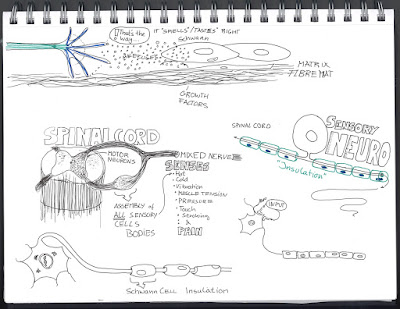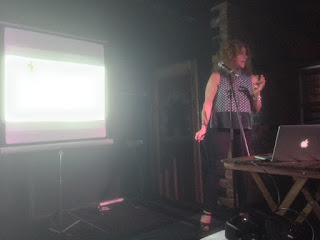Pint of Science Glasgow 15.5.2017
Beautiful Mind: What can we do to repair the nerves of your body?
Short summary:
An accident-you stepped on a bottle and damaged a nerve–what happens next, what can be done is my story. Nerve cells help you feel and move. Nerve cells stretch out from the spine, that means repair has to cover quite a distance. The cut is stitched by a surgeon so that repair can start. That repair is slow and not always as good as new. I lead a group that tries to help by developing a diverse array of new therapies: tiny tubes to guide repair; helper cells; special cell friendly paint; a ‘sonic screwdriver’, electricity to ‘zap’ cells into action; and drugs and food supplements that may help.
if you are interested, the slides of the whole talk are all available here: LINK
How did the talk come about?
Sara Hosseinzadeh, a joint PhD student I co-supervise together with Sue Barnett, asked in December, and I was happy to agree at the time. More recently it was so busy that I did not have much time the weeks beforehand to work on the presentation, time was fleeting, and the date came ever closer. Pressure was mounting, not helped by a huge pile of marking that took up all of Saturday, that only left Sunday to prepare the talk, very much to the delight of the family... It seems in the back of my mind I had thought about what I wanted to talk about for some time, so thankfully I woke up Sunday morning at 4am with a head full of buzzing ideas, so the only way to quieten this was to go down, take the puppy as a warming lapdog, and doing a "brain dump" on paper (see Sketchnote No 1 below) to capture the structure of the talk.
Sketchnote No 1
Making quite a few of the slides, thinking about the flow, finding the right images in talks by the group, testing the ideas for the flow while going through the slides over and over again, the talk slowly - very slowly took shape, all the time bing aware that the deadline for submission had long passed it was more or less finished at about 23:30 (OK I had a 3h break in the afternoon at a very nice garden party with gazebo and pouring rain.
Monday morning thankfully remembering that I wanted a prop, I cut off a bit of our garden hose, to have an "axon" at hand to make myself into a representative neuron to show together with a map of Glasgow how very long axons can be, if they extend from the spinal cord to the fingertips or toes. Then at Uni I tested the talk with the group to see what could be improved, simplified, was the flow of ideas OK, better figures, and finalised the talk there and then. We (Jemma, Marie, Suzanne, Ricky, Rob and myself) then drew neurons shapes on strips of parafilm to have a prop for the audience to pull on and grow some nerve.
A box full of parafilm neurons, ready to grow
All finished by about 12 midday I was tentatively ever so slightly confident, but still apprehensive as this audience was an unknown entity to me ranging from people who come and have no background whatsoever to colleagues whom you also want to entertain - it was such an unknown ...
One of the slides on how neurons react to being cut
Another drawing, in the end I did not use it as there were some nicer figures in one of my other presentations
Well in the end I think the evening went really well, I enjoyed it and I hope so did the audience, the questions were nice and so was the feedback while waiting to be served - finally with a beer.
Starting off with the nice talk by Sue about the cells of the central nervous system and specifically - how do axons get myelinated - one of her long lasting research interests.
Sue Barnett talking about glia...
Sue's talk was followed by a quiz on the central nervous system, with some what we thought potentially ambiguous answers (is the synaptic space part of a neuron or not - we thought not...).
After my talk Graham spoke about his work on establishing relly long term stable cultures (there are some that have lasted longer than a year!) in microfluidic chips - brain in a chip to study Alzheimer's disease. With that the evening more or less concluded and i went home quite content that I may have got people interested to follow this evening up...
I was very happy with the Pint of Science team who supported the talks and did a stellar job at organising everything. And am now a proud owner of a Pint of Science pint glass, only thing missing is the beer to replace the air within (auto-refill would be a nice feature)...
PS: the axon prop that I forgot to pick up did get some appropriate use afterwards
The slides of the whole talk are all available on Dropbox: LINK

Part of the audience
Me talking
Schedule for the night...











